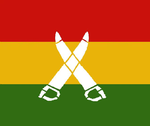
Back حركة غدر Arabic গদর পার্টি Bengali/Bangla Partit Ghadar Catalan Partido Ghadar Spanish Ghadar-liike Finnish Mouvement Ghadar French ग़दर पार्टी Hindi ಗದ್ದರ್ ಪಕ್ಷ Kannada ഗദ്ദർ പാർട്ടി Malayalam गदर पार्टी Marathi
Ghadar Party | |
|---|---|
 | |
| President | Sohan Singh Bhakna |
| Founded | 15 July 1913 |
| Dissolved | January 1948 |
| Ideology | Indian independence Indian nationalism |
| Colours | Red, Saffron, Green |
The Ghadar Movement or Ghadar Party was an early 20th-century, international political movement founded by expatriate Indians to overthrow British rule in India.[1] Many of the Ghadar Party founders and leaders, including Sohan Singh Bhakna, would go on and join the Babbar Akali Movement and would help it in logistics as a party and publishing its own newspaper in the post-World War I era.[2] The early movement was created by revolutionaries who lived and worked on the West Coast of the United States and Canada, but the movement later spread to India and Indian diasporic communities around the world. The official founding has been dated to a meeting on 15 July 1913 in Astoria, Oregon,[3] and the group would splinter into two factions the first time in 1914, with the Sikh-majority faction known as the “Azad Punjab Ghadar” and the Hindu-majority faction known as the “Hindustan Ghadar.”[4] The Azad Punjab Ghadar Party’s headquarters and anti-colonial newspaper publications headquarters would remain in the Stockton Gurdwara located in Stockton, California, whereas the Hindustan Ghadar Party’s headquarters and Hindustan Ghadar newspaper would relocate to be based in nearby Oakland, a suburb of San Francisco, California.[4]
Following the outbreak of World War I in 1914, some Ghadar party members returned to Punjab to incite armed revolution for Indian Independence. Ghadarites smuggled arms into India and incited Indian troops to mutiny against the British. This uprising, known as the Ghadar Mutiny, was unsuccessful, and 42 mutineers were executed following the Lahore Conspiracy Case trial. From 1914 to 1917 Ghadarites continued underground anti-colonial actions with the support of Germany and Ottoman Turkey, known as the Hindu–German Conspiracy, which led to a sensational trial in San Francisco in 1917.
Following the war's conclusion, the party in the United States fractured into a Communist and an Indian Socialist faction. The party was formally dissolved in 1948.[1] Key participants in the Ghadar Movement included K. B. Menon, Sohan Singh Bhakna, Mewa Singh Lopoke, Kesar Singh(Vice-President), Baba Jawala Singh(Vice-chair), Balwant Singh, Santokh Singh, Bhai Parmanand, Vishnu Ganesh Pingle, Bhagwan Singh Gyanee, Har Dayal, Tarak Nath Das, Bhagat Singh Thind, Kartar Singh Sarabha, Udham Singh, Abdul Hafiz Mohamed Barakatullah, Rai Nawab Khan, Rashbehari Bose, and Gulab Kaur. Although its attempts at overthrowing the British Raj were unsuccessful, the insurrectionary ideals of the Ghadar Party influenced members of the Indian Independence Movement opposed to Gandhian nonviolence. To carry out other revolutionary activities, "Swadesh Sevak Home" at Vancouver and United India House at Seattle was set-up.[5]
- ^ a b "Ghadr (Sikh political organization)". Encyclopædia Britannica. Archived from the original on 10 November 2010. Retrieved 18 September 2010.
- ^ Singh, Satindra (1966). Ghadar, 1915, India's First Armed Revolution (3rd ed.). R & K Publishing House. pp. 133–135.
- ^ Ogden, Joanna (Summer 2012). "Ghadar, Historical Silences, and Notions of Belonging: Early 1900s Punjabis of the Columbia River". Oregon Historical Quarterly. 113 (2): 164–197. doi:10.5403/oregonhistq.113.2.0164. JSTOR 10.5403/oregonhistq.113.2.0164. S2CID 164468099.
- ^ a b Singh, Gurdev (1969). The Role of the Ghadar Party in the National Movement (3rd ed.). University of California. pp. 72–77. ISBN 9780842612340.
- ^ Aspirant, Civil (4 July 2020). "203. Tarak Nath Das- Founder of Swadesh Sevak Home". Civil Aspirant. Archived from the original on 18 May 2022. Retrieved 5 July 2022.
© MMXXIII Rich X Search. We shall prevail. All rights reserved. Rich X Search